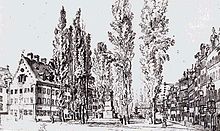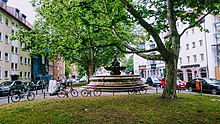Maxplatz (Nuremberg)
The Maxplatz (formerly Maximilianplatz originally. New construction ) is an elongated, extending in an east-west direction road space in the old town of Nuremberg. Originally it was a baroque square, which today is only rudimentarily recognizable in outline . It lies parallel to the Pegnitz, which runs south, directly inside the city wall at Hallertor , from which it extends towards the main market . In the west, the Kettensteg connects Maxplatz with Kreuzgasse, in the east the Maxbrücke leads to Unschlittplatz . The Weißgerbergasse runs to the northeast .
history

Baroque period
The Neuerbaw , later called Neuer Bau or Auf dem neue Baue , was built in the Baroque period. Formally, it is reminiscent of the Piazza Navona in Rome with its elongated floor plan, rounded at one end . Like these, he had three fountains from 1684, the mighty baroque Triton Fountain - inspired by the Roman Fontana del Tritone - in the center of the square and its two side fountains. The square was otherwise kept free and not planted with trees in the 17th and 18th centuries.
1806 to 1945
After Nuremberg was incorporated into the Kingdom of Bavaria in 1806 , the square was renamed Maximiliansplatz in honor of the reigning King Maximilian I. Around the same time (until 1811) the square was then consistently redesigned in a romantic - classicist sense. The Triton Fountain lost its baroque fountain grille. As part of the redesign, the two side wells also disappeared. The square was then planted with two rows of poplar trees and the middle of the square was graveled as a promenade. The redesign was evidently met with considerable but unsuccessful resistance, especially from the resident and former patrician Jakob Gottlieb Friedrich von Tucher. The city commissioner , the Bavarian higher authority disregarded this.
In 1821 the classicistic Dürer-Pirckheimer fountain was built at the eastern end of the square . In the second half of the 19th century, the poplars were replaced by plane trees.
The area around Maxplatz was considerably destroyed in air raids in 1945, the Triton Fountain was partially destroyed.
After 1945
In 1967 the central green area was partially destroyed by the traffic-oriented redesign of the square and its inclusion in the (now closed) east-west passage of the Sebald old town. “In order to create space for the traffic axis, the formerly strict building rectangle to the east of the fountain was given a wedge-shaped extension to the north into the ruins, while in the west the green area was cut off at an angle and narrowed down to a few meters. (...) Well and system, previously (...) located symmetrically in the middle of the building, now moved to the edge (...). ” As part of this fundamental redesign of the square, the northern series was completely felled on the western side of the square. The excessively wide (formerly marked four-lane) lane is now also used for parking.
Listed objects
- House No. 7: three-storey sandstone block building, 1807, in the New Nuremberg style .
- House No. 17: three-storey sandstone block construction, 1720, late baroque.
- House No. 29: late 16th century, baroque style around 1750/60, late gothic, baroque, rococo.
- House No. 34: front building from 1682, garden room from 1680, reworked in 1789.
- House No. 35: Two-storey sandstone building, the core of the 16th century, remodeled in the 19th century.
- House No. 46a: four-storey plastered building, 16./17. Century, remodeled in the 19th century in neo-Renaissance style.
- House No. 48: four-storey sandstone / plastered building, the core of the 16th century, Renaissance, remodeled in 1899 in neo-renaissance and neo-baroque style.
- Dürer Pirckheimer Fountain, 1821.
- Triton Fountain , 1687.
literature
- Erich Mulzer: The Triton Fountain on Maxplatz - a piece of unknown Nuremberg? In: Altstadtfreunde Nürnberg eV (Hrsg.): Nürnberger Altstadt reports. No. 19, Nuremberg 1994, p. 27 ff.
Individual evidence
- ^ Engraving by Delsenbach, dated 1720
- ↑ Submission by the Nuremberg Artists and Art Friends Association of September 28, 1811, regarding the removal of the fountain grids at the Tugendbrunnen and Triton Fountain (done) and at the Schön Brunnen , (not done), as well as the large bronze grating in the great hall of the town hall (done) / StAN Rep. 170-1 No. 4629
- ↑ a b Erich Mulzer: The Triton Fountain ... 1994.
- ↑ AvN C2 Police Directorate No. 516 Bl. 9, 10, 26 47.
Coordinates: 49 ° 27 ′ 15.8 ″ N , 11 ° 4 ′ 21 ″ E


